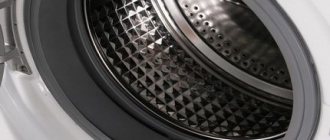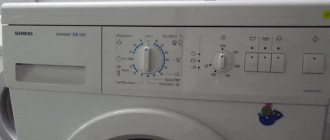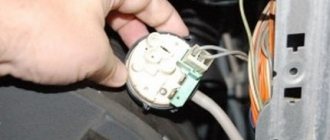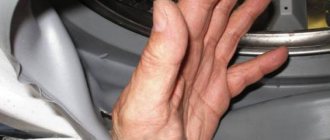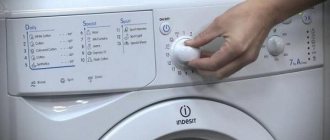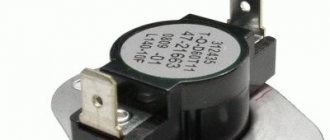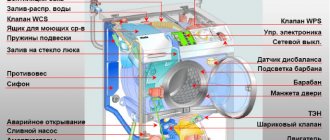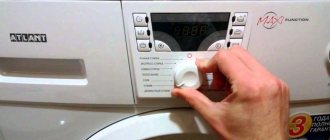The washing machine beeps during washing
- The most likely causes of squeaking
- Loosening the belt
- Counterweight instability
- Hitting objects
- Rust on bearings
- Weak shaft fastenings
- Spring wear
- Friction of body parts
- The Atlant machine beeps
Many housewives are faced with a situation where a washing machine that has been in service for some time beeps when washing. The squeaking sound is heard throughout the entire process, or during rinsing and spinning mode. The most likely reason is wear of parts and loose fasteners. If you do not have the ability or skill to repair the device yourself, then you should contact a specialist.
The most likely causes of squeaking
Modern washing machines of some brands are equipped with devices that notify with a sound when the wash is complete. This feature should be indicated in the instructions for the machine. If the squeak is not a warning sound, then the reasons should be sought in the wear and tear of the household device.
The squeak is a consequence of:
- loosening the belt driving the drum;
- violation of counterweight stability;
- getting stuck small objects and items of clothing;
- rust formation on bearings;
- loosening of the shaft fastenings;
- high degree of spring wear;
- friction of body parts against each other at the joints.
Let's take a closer look at why the washing machine beeps.
Loosening the belt
If the machine is an old brand, without direct drive, then it is most likely that the belt that makes the drum move has weakened. The stretched belt slips, emitting a pronounced squeak. Moreover, the sound is heard when the washing is in active mode, the machine is filled with a large number of things.
To check whether the belt is really to blame for the sound, you need to get to it:
- remove the back cover, behind which the wheel - pulley is located;
- see if there is damage to the pulley;
- inspect the drive belt put on the wheel.
Counterweight instability
By removing the cover of the machine, you can see the counterweight. It looks like a massive gray block. The part requires replacement if the diameter of the fastening holes has become wider than the diameter of the fastening bolts. To make sure that the structure is shaky, just shake it in different directions. If the counterweight is wobbly, it's time to replace it.
Hitting objects
When loading clothes into the car, housewives often forget to check the pockets for small items and coins. During washing, this little thing spills out and penetrates through the hole in the cuff into the space between the drum and the tank. During the washing mode, the surface of the drum rubs against objects, producing squeaking and squeaking noises.
To check whether small items are stuck inside, you need to unscrew the wall of the washing machine (back or front, determined by the model of the device), and unfasten the heating element. Through the hole for the heater you can see the objects inside and remove them.
Rust on bearings
If the drum beeps during washing mode, the problem may be serious and require professional repair. The drum is attached to a shaft, which is inserted into the tank on bearings. The bearings are protected from moisture penetration by an oil seal. This rubber device gradually dries out and defects appear on it. A damaged seal allows water to pass through. As a result, the bearings become covered with rust and begin to creak and squeak during operation.
Weak shaft fastenings
The problem is not often diagnosed, but it does happen. Gradually, if the washing machine operates in active mode, the shaft fastenings become loose and weakened. The problem can also be a consequence of a manufacturing defect. The result is an imbalance of the drum, the appearance of a characteristic squeak. The problem is easily fixed: you just need to tighten the bolts. But getting to them is problematic; it is better to entrust this matter to a professional.
Spring wear
When your washing machine beeps loudly during the spin cycle, the problem may be worn springs. When the device is working, the tank shakes and the springs rub at the attachment point, producing an unpleasant thin sound.
To confirm the cause of the sound, you need to turn on the washing mode by removing the cover of the machine. Then press on the springs. If the beeping stops, then the problem has been identified correctly. Usually, to eliminate it, it is enough to apply lubricant to the places where the springs are attached. But sometimes it is necessary to replace elements that have become unusable.
Friction of body parts
The fastening elements of the body gradually weaken, and the moving parts begin to squeak and grind when rubbing against each other. The sound is not only characteristic of worn-out devices; it can be the result of a manufacturing defect. You should carefully inspect the car and tighten any loose fasteners.
If, after a thorough check, the cause of the squeak cannot be identified, you will have to contact a qualified technician to carry out diagnostics and repairs.
The squeak is not coming from the speaker
When a squeak is heard not from the washing machine speaker, but from the drum, behind or from above, then the problem is different. It is likely that the audible sound only resembles a squeak, but in reality sounds different. Rather, the user is “deceived” by the following malfunctions:
In such cases, the squeak is necessarily accompanied by a suspicious clanging, grinding and humming sound. But the problem can be solved faster and without the involvement of professional craftsmen. So, if the reason for the squeaking is in the belt, then you need to remove it, wash it in a soapy solution and lubricate it with crushed pine rosin. The last thing is most important - the belt will not slip and make an unpleasant squeaking sound.
When the counterweight is to blame for the squeak, we act differently: remove the top panel of the machine, free the wiring and control board, and then visually assess the condition of the concrete blocks. Next, we check the concrete with several clicks and, if we suspect loose bolts, tighten the fasteners. If cracks or chips are visible, replacement will be required.
Further operation of the machine with a loose drive belt, unfixed counterweights and a foreign object in the tank is strictly prohibited.
To remove a foreign object from the washing machine, remove the back panel, drive belt and find where the heating element is located. The latter must be removed and through the vacated hole penetrate into the space between the drum and the tank. It is enough to illuminate the space with a flashlight, fix the foreign body, and then take long tweezers and pull out the thing.
The Atlant machine beeps
The explanation is as follows: the display unit functions in conjunction with the program selector, which in a car of this brand is not particularly reliable, and as a result of operation it begins to squeak.
Due to the fact that the Atlant washing machine beeps, it does not work worse. Occasionally the image on the display gets confused: instead of the selected mode, another one is shown. The message SEL may appear, indicating that the selector is operating incorrectly.
The annoying sound can be eliminated simply by replacing the display module. But after some time the problem may return.
Squeaking in the ATLANT typewriter
All of the above does not apply to owners of the Atlant 50C82 series washing machine. This machine also beeps, but it does it a little differently and for a completely different reason. Here the display unit and the program switching unit are to blame for the annoying sounds.
The squeak is explained as follows: the display unit only works in conjunction with the mode switch, which is not of a reliable design. The reason for the squeaking sound is in the gear selector.
It is worth noting that squeaking does not affect the performance of the washing machine. It is extremely rare that failures may occur in the form of erroneous display of one program on the display instead of the one selected by the user. For example, the regulator stops at the “Cotton” mode, and the indicator shows the time and temperature for “Quick Wash”. Sometimes the “SEL” error appears at the same time, which stands for “selector malfunction.” At Atlant, the squeak is eliminated by replacing the display module. You can try to repair it, but often the breakdown comes back again.
Why does the washing machine make a lot of noise when spinning?
Strong noise during AFM operation occurs because:
- The transport bolts securing the tank were not removed before use.
- The ACM is not installed as specified in the operating instructions.
- The washing machine has been in use for a long time and as a result the drum bearings have worn out.
- A foreign object has entered the space between the tank and the drum.
- The drum pulley or the drive belt that transmits torque from the electric motor to the pulley is loose.
- The fastening of the counterweights that stabilize the AFM during drum rotation is broken.
Extraneous noise in the washing machine during the spin cycle can occur both immediately after purchasing the equipment and after several years of its operation. If the unit hums from the very beginning, the reasons are quite easy to eliminate. But if the noise level during drum rotation increases after a long time, the SM will have to be repaired.
Eliminating the causes of noise during operation
Depending on what factors led to the hum, whistle and other sounds during the spin cycle, certain actions should be taken. In addition to the reasons that are characteristic of all ACM models, there are those that depend on the design features of individual brands of machines: LG, Ariston, Electrolux and other brands.
Transport bolts
One of the most common situations that can lead to serious damage to the machine. Often, craftsmen installing a new SM, in a hurry, forget to remove the bolts designed to secure the drum during transportation.
If the washing machine makes strange sounds when spinning during the first wash, knocking and other specific sounds are heard, you should immediately check whether the bolts have been removed from the body.
Foreign object in tank
Very often, when loading laundry into the drum, owners do not check the contents of their pockets. And there may be coins, pins and other small objects that can fall from the drum into the tank.
When the drum shakes and rotates at low speed during washing, small objects do not make themselves felt. As soon as the spin cycle begins and the vibration increases, objects begin to move, falling into the gap between the tank and the drum. As a result, the washing machine rattles during the spin cycle, whistles, hisses and rumbles.
You can solve this problem yourself. To remove a foreign object, turn off the power to the AFM, remove the back cover and release the heating element by removing the fasteners. Its most common location is under the tank, near the electric motor. After this, carefully remove the foreign object from the resulting niche using your fingers or a handy tool, for example, long pliers or a medical clamp.
This video describes how to remove foreign objects from the tank:
Bearings are worn out
In most cases, the drum rotates inside the washing machine tub on two bearings. These parts are subject to wear, especially due to vibration caused by the large amount of laundry in the drum. Another reason for their destruction is the ingress of water and detergents through a leaky oil seal.
If the washing machine hums during the spin cycle, it is worth checking the condition of the drum ball bearings. To do this, you need to turn off the power to the SM, open the hatch, put your hand into the drum and turn it in one direction, and then in the other. If the bearings are in good condition, a slight rustling noise will be heard when rotating. A cracking, knocking or slight hum will indicate damage to parts.
Replacing bearings and oil seals is a difficult and troublesome task. We'll have to disassemble the AFM completely. If the tank is plastic and cannot be disassembled, you will need to completely replace the expensive unit. True, there are craftsmen who cut the tank and replace parts themselves. Then the tank is glued together and the SM is successfully used further. But if you do not have the experience and necessary skills in handling tools, it is better to entrust the replacement to a qualified craftsman.
This video provides information on how to replace bearings in a non-separable plastic tank ASM Ariston:
Loose pulley or belt
If the washing machine makes noise during the spin cycle and clicks are heard, you should pay attention to the drum pulley and drive belt. As a rule, such a defect appears after prolonged use. During this time, the belt can stretch, shift and slip in the pulley. If the pulley mounting nut is loose, it can rotate relative to the drum.
You can diagnose such malfunctions by running a test mode or hand wash (the drum should rotate slowly). If extraneous sounds do not disappear, you should remove the back cover and inspect the parts. First of all, tighten the pulley mounting nut - it is quite possible that it has become loose. For more reliable fixation, you can apply sealant to the nut. Check the belt tension and adjust it if necessary. If after these steps the noise level does not return to normal, replace the belt.
Counterweights are shifted
The tank is attached to the SM body with springs to minimize vibrations during spinning. For the same purpose, counterweights located around the tank are used. In most ACM models they are attached to the tank with screws.
Under heavy loads and after prolonged use, the fastenings of the counterweights may become loose. In this case, the parts change position, shifting the center of gravity of the tank. As a result, the washing machine makes noise when spinning, and also vibrates strongly, rumbles and even bounces. This problem can be eliminated by tightening the fastening nuts or screws securing the concrete blocks until they stop. In order to get to the counterweights, you will have to remove the top and back covers.
Incorrect installation
Carelessness when placing and leveling the SM on the floor can lead to its imbalance during operation. If the unit is not installed level and all legs do not rest properly on the floor surface, during spinning there will be a rumble, rattling and displacement of the ASM relative to its place.
It’s easy to check that the installation is correct: just place a level on the top cover. If it is misaligned, you will have to level the machine by adjusting the height of the legs.
As you can see, you can independently eliminate the reasons that the washing machine is noisy during the spin cycle. The only exception is bearing wear. But if you have plumbing skills and experience in handling tools, such a problem can also be fixed on your own.
What does the OE error mean?
It often happens that an LG washing machine issues an OE code during a spin cycle or in the middle of a program while the wash is still in progress. The user faces a serious problem as the drum is full of wet laundry. To understand what happened, you will need to correctly decipher the error that appears on the equipment screen.
The OE code appears on the display when the washing machine starts the drain pump. In fact, at this moment the water should be removed from the drum, but in fact it remains inside, hence the error.
When programming the machine, the manufacturer provided a short period of time during which the attempt to drain the water should be repeated. If even after 5 minutes nothing changes and the liquid remains inside, the system issues an OE.
It is necessary to understand why the pump, which is responsible for removing water from the drum, cannot do its job. There may be several reasons for this:
- a garbage plug has appeared in the filter or hose;
- drain pump failure;
- debris may accumulate in the sewer system;
- the water level sensor has become unusable;
- failure of the electrical controller.
The last cause of failure often manifests itself not only in the described error. The user should observe how the equipment works by activating different operating modes.
You should not immediately send the equipment for repair. First of all, you need to check the hoses for blockages.
First, they check the quality of the sewerage system. To do this, open the taps and observe how quickly the water leaves. If everything is fine, you should check the filter and drain hose directly on the washing machine.
The first thing to inspect is the garbage filter. It must be cleaned well, preferably rinsed with water. If it is clean, but the error still appears, then the reason is different. The blockage may be between the siphon and the equipment filter. If the connection is made directly, and the drain hose is inserted directly into the sewer, then you should look for the blockage there. Heavy dirt plugs are removed using steel wire.
If there are no problems with clogging, you should pay attention to the operation of the pump. In this technique they are quite noisy
Extraneous sounds are easy to hear. However, if the equipment works quietly, this is also an indicator of a problem.
The OE error may occur due to incorrect operation of the electrical controller or sensor responsible for the water level. In both cases, it is not recommended to carry out independent repairs; it is better to contact a specialist.
Video on the topic
The story is about the reasons why extraneous noise occurs in the washing machine and the procedure for eliminating them:
Electronic engineer with many years of experience. For several years I was engaged in organizing the repair of household appliances. I am glad to share with readers my knowledge in the field of operation and repair of devices. Loves sport fishing, water tourism and travel.
Found a mistake? Select the text with the mouse and click:
The habit of using an automatic washing machine “sparingly” can lead to the appearance of an unpleasant odor in it. Washing at temperatures below 60℃ and short rinses allow fungi and bacteria from dirty clothes to remain on internal surfaces and actively multiply.
Threads made of gold and silver, which were used to embroider clothes in the old days, are called gimp. To obtain them, the metal wire was pulled for a long time with pliers to the required fineness. This is where the expression “to drag out the rigmarole” came from - “to do long, monotonous work” or “to delay the completion of a task.”
The dishwasher cleans more than just plates and cups. You can load it with plastic toys, glass lamp shades and even dirty vegetables, such as potatoes, but only without using detergents.
Before removing various stains from clothing, you need to find out how safe the selected solvent is for the fabric itself. It is applied in a small amount to an inconspicuous area of the item from the inside out for 5-10 minutes. If the material retains its structure and color, you can move on to stains.
Stretch ceilings made of PVC film can withstand from 70 to 120 liters of water per 1 m2 of their area (depending on the size of the ceiling, the degree of its tension and the quality of the film). So you don’t have to worry about leaks from neighbors above.
If your favorite things show the first signs of gestation in the form of untidy pellets, you can get rid of them using a special machine - a shaver. It quickly and effectively shaves off clumps of fabric fibers and returns things to their proper appearance.
The easiest way to remove scale and carbon deposits from the soleplate of the iron is with table salt. Pour a thick layer of salt onto the paper, heat the iron to maximum and run the iron over the salt bed several times, applying light pressure.
There are special traps to combat moths. The sticky layer with which they are covered contains female pheromones that attract males. By sticking to the trap, they are eliminated from the reproduction process, which leads to a decrease in the moth population.
Fresh lemon is not only suitable for tea: clean dirt from the surface of an acrylic bath by rubbing with half a cut citrus, or quickly wash the microwave by placing a container of water and lemon slices in it for 8-10 minutes at maximum power. The softened dirt can simply be wiped off with a sponge.
Why does the washing machine beep during washing?
The washing machine squeaked - what to do?
The drum in the washing machine squeaks
Small items got into the washing machine
Springs and shock absorbers
The body of the machine creaks
Your washing machine was working, working and suddenly creaked. Why could this happen? There may be several reasons, just as the creaking itself can be different and can be caused by different parts of the washer. If your washing machine squeaks, then the first thing you need to do is find out what caused this sound, and based on the cause, you can fix the problem. Therefore, we will describe for you all possible reasons and ways to solve them.
The drum in the washing machine squeaks
If you notice that the washing machine drum squeaks when rotating, then there may be a rather serious reason that will require disassembling the washing machine. The drum is connected to a shaft, which is mounted in the tank on bearings. To prevent water from getting on the bearings during washing, a rubber seal is placed on them, which can dry out or become damaged over time. If this happens, the oil seal, which should be lubricated with a waterproof lubricant, begins to let water through, which in turn gets onto the bearings. Moisture causes the bearings to rust and squeak.
If the washing machine squeaks during washing precisely because of the bearings, then you need to immediately stop using it, since subsequent operation of the bearings in this mode can cause their complete failure. If this happens, other parts of the washing machine may be damaged and repair may no longer be possible.
Another reason for a squeaking drum in a washing machine may be a weakened shaft. This happens extremely rarely, but still. Over time or poor assembly, the mounting bolts may become loose. As a result, the drum will become unbalanced and a creaking sound will appear. It can be removed very simply by tightening the bolts, although getting to them is not always easy.
Small items got into the washing machine
Very often, owners forget to take small items, change, etc. out of the pockets of things they send for washing. This leads to the fact that during washing these small things fall into the drum and through the gap in the cuff can get into the gap between the tub and the drum . During washing, the drum begins to rub against them and a creaking or knocking noise occurs.
To check and get these small things, you need to remove the wall of the washing machine (front or back - depending on the model) and unscrew the heating element; through the hole for the heating element you can get out all the small things that have fallen into the space between the tank and the drum.
If you hear the characteristic creaking of the washing machine drum on the cuff, then the reason may be that during washing, for example, a bra bone got into the washing machine drum or other small things could get into the cuff itself and get stuck there. Check the entire cuff for small particles; if there is any, be sure to eliminate it.
If your machine is not direct drive and has been in use for several years, then there is a high probability that the belt that drives the drum has worn out. When the belt stretches, it begins to slip, producing a characteristic squeak. Please note that if your belt is stretched, the creaking will occur under heavy loads, i.e. when a lot of laundry is loaded into the drum.
If it is the belt that is to blame, then it needs to be replaced. In some cases, it is possible to simply increase its tension.
Springs and shock absorbers
Springs and shock absorbers can cause the washing machine to squeak during washing and especially spinning. The springs themselves may squeak. The springs are fixed at the top in special holes. During washing, they can rub against their mounting holes and make unpleasant noise. This malfunction is not critical and can be easily corrected.
In order to determine that the cause of the squeaking is in the springs, remove the top cover from the washing machine and run the wash without it. During washing, when the squeaking starts, hold the springs at their connection with the mounting hole (just press with your hand). If the squeak disappears, then this is the reason. To eliminate squeaking, you can simply lubricate the springs in these places using any lubricant.
The second option is wear of the springs or shock absorbers, as a result of which the tank sways during washing and comes into contact with the walls of the washing machine, which causes creaking. You can run the wash without the top cover and see if the tank is rubbing against the walls of the washing machine and what causes this malfunction. Inspect the shock absorbers and springs; they should not be damaged. The shock absorbers must be well tightened and of course they must absorb shock. If they have too much travel and are not doing their job, replace them.
The body of the machine creaks
If the machine was poorly assembled, then over time some of the fastenings of the body could become loose and make a squeaking sound during washing. This usually happens with the walls of the machine. In order to eliminate this reason, you need to tighten all the bolts that connect the body to each other. It is also a good idea to inspect other connections that may also have become loose, such as the counterweight mounts.
My washing machine makes noise during the spin cycle.
Do you hear knocking, clicking, buzzing or feel vibration during the spin cycle?
The reason may be:
The washing machine may make noise if the load is not distributed evenly. → Stop the washing machine and lay out the laundry.
The washing machine may make noise if the laundry is unevenly distributed. In this case, stop the washing machine by pressing the [Start/Pause] button, redistribute the laundry and restart the machine.
Is the washing machine knocking or the door shaking?
→ The washing machine spins and stops several times to balance the load and speeds up when the load balances. During this process, you may feel vibration and knocking. The noise will decrease once it starts rotating after balancing the load. The door is designed not to open during operation, so you can be confident .
→ Remove items that cause uneven distribution.
Do not place door mats, rugs, carpets, rubber mats, heated blankets, etc. in the wash. These items can cause unbalanced loads and may prolong the spin cycle as it takes longer to balance the load of laundry. Press the [Pause] and remove items
Does your washing machine make a rattling sound during the spin cycle?
→ Remove foreign objects from the tank/drum.
Check and remove any foreign objects inside the tank/drum such as hairpins, coins and other accessories.
Is your washing machine making a whirring noise before spinning when the water is draining?
→ Remove foreign objects from the drain filter.
The whirring sound before the spin cycle is the sound of the drain pump. Therefore, the humming noise you hear is normal, but if the sound becomes too loud, you should check the drain pump filter.
Is the drain hose or water supply hose banging against the back of the washing machine?
→ Move the stripping machine so that there is enough space.
The water supply and drain hose may hit the machine due to vibration. If this causes noise, move the washing machine away so that there is enough space between it and the wall.
Is your washing machine hitting the shelves and cabinets around it?
→ Leave enough space between the washing machine and objects around it.
If the washing machine is installed and leveled correctly, there will be no such problem or noise. However, if you hear a loud noise, check to see if the washing machine is moving or hitting objects around it. It is recommended to leave enough free space around the washing machine.
The washing machine may make knocking or rattling noises if it is not leveled.
→ If the washing machine shakes during the spin cycle, level the washing machine.
During the spin cycle, the drum rotates at a very high speed. Therefore, it is important that the washing machine is leveled to reduce noise and vibration. Gently rock the machine from corner to corner to check if it is level. If the unit shakes, use a wrench to adjust the leveling feet up or down, leveling the washer and making sure the feet are firmly seated on the floor.
Need more help?
If you need further assistance, please contact us via email, live chat or phone.
You can easily find our contact information on our website.
Go to the [Support] menu and select [Email / Chat / Phone] to ask us additional questions!
You can also request a service visit in the
[Repair Request]
and have our technicians check your equipment.
▶ This content is for informational purposes only and may contain images and information that differ from the product you purchased.
The most likely causes of squeaking
Modern washing machines of some brands are equipped with devices that notify with a sound when the wash is complete. This feature should be indicated in the instructions for the machine. If the squeak is not a warning sound, then the reasons should be sought in the wear and tear of the household device.
The squeak is a consequence of:
- loosening the belt driving the drum;
- violation of counterweight stability;
- getting stuck small objects and items of clothing;
- rust formation on bearings;
- loosening of the shaft fastenings;
- high degree of spring wear;
- friction of body parts against each other at the joints.
Let's take a closer look at why the washing machine beeps.
Loosening the belt
If the machine is an old brand, without direct drive, then it is most likely that the belt that makes the drum move has weakened. The stretched belt slips, emitting a pronounced squeak. Moreover, the sound is heard when the washing is in active mode, the machine is filled with a large number of things.
To check whether the belt is really to blame for the sound, you need to get to it:
- remove the back cover, behind which the wheel - pulley is located;
- see if there is damage to the pulley;
- inspect the drive belt put on the wheel.
The belt should be inspected carefully. Even a small crack can negatively affect the performance of the part and cause an unpleasant squeak. If damage is found, the belt must be replaced. But sometimes it is enough to increase the tension of the drive part.
Counterweight instability
By removing the cover of the machine, you can see the counterweight. It looks like a massive gray block. The part requires replacement if the diameter of the fastening holes has become wider than the diameter of the fastening bolts. To make sure that the structure is shaky, just shake it in different directions. If the counterweight is wobbly, it's time to replace it.
Hitting objects
When loading clothes into the car, housewives often forget to check the pockets for small items and coins. During washing, this little thing spills out and penetrates through the hole in the cuff into the space between the drum and the tank. During the washing mode, the surface of the drum rubs against objects, producing squeaking and squeaking noises.
To check whether small items are stuck inside, you need to unscrew the wall of the washing machine (back or front, determined by the model of the device), and unfasten the heating element. Through the hole for the heater you can see the objects inside and remove them.
Rust on bearings
If the drum beeps during washing mode, the problem may be serious and require professional repair. The drum is attached to a shaft, which is inserted into the tank on bearings. The bearings are protected from moisture penetration by an oil seal. This rubber device gradually dries out and defects appear on it. A damaged seal allows water to pass through. As a result, the bearings become covered with rust and begin to creak and squeak during operation.
If the squeaking sound of the washing machine is a consequence of rusting of the bearings, then washing should be stopped immediately. If damaged bearings continue to operate as before, they will completely break down. And this will certainly lead to the breakdown of other elements, and the car will have to be scrapped. The only option to do in this situation is to contact a workshop.
Weak shaft fastenings
The problem is not often diagnosed, but it does happen. Gradually, if the washing machine operates in active mode, the shaft fastenings become loose and weakened. The problem can also be a consequence of a manufacturing defect. The result is an imbalance of the drum, the appearance of a characteristic squeak. The problem is easily fixed: you just need to tighten the bolts. But getting to them is problematic; it is better to entrust this matter to a professional.
Spring wear
When your washing machine beeps loudly during the spin cycle, the problem may be worn springs. When the device is working, the tank shakes and the springs rub at the attachment point, producing an unpleasant thin sound.
To confirm the cause of the sound, you need to turn on the washing mode by removing the cover of the machine. Then press on the springs. If the beeping stops, then the problem has been identified correctly. Usually, to eliminate it, it is enough to apply lubricant to the places where the springs are attached. But sometimes it is necessary to replace elements that have become unusable.
Friction of body parts
The fastening elements of the body gradually weaken, and the moving parts begin to squeak and grind when rubbing against each other. The sound is not only characteristic of worn-out devices; it can be the result of a manufacturing defect. You should carefully inspect the car and tighten any loose fasteners.
If, after a thorough check, the cause of the squeak cannot be identified, you will have to contact a qualified technician to carry out diagnostics and repairs.
Professional repair
If after cleaning the fault remains, a more in-depth and complex diagnosis will most likely be required, requiring the intervention of a specialist. Here we are talking about repairs or replacement of spare parts by service center employees.
Cases requiring professional repair:
- replacing the drain pump (pump);
- malfunction of the spillway sensor (pressostat);
- partial damage to electronics (chips);
- failure of the control unit (electrical controller).
If the pump impeller has already been cleaned of dirt, its other part, the engine, is checked for serviceability. A multimeter is connected to it to measure the resistance. If the instrument readings give an infinite value, the pump has failed and must be replaced with a new one.
When 0E is displayed, the machine sometimes drains the water, but does not spin. It is possible that the water level sensor does not detect its absence and therefore blocks further washing. This mechanism is more complex - the problem may lie in a leak, faulty wiring, or oxidation of contacts as a result of high humidity in the unit housing.
A more complex case at 0E is problems with electronics. For example, a burnt resistor is easy to see when examining an electrical controller board, but many other faults cannot be seen externally. In this case, detailed diagnostics are carried out: first of all, those parts of the microcircuit that are responsible for the operation of the drain system are checked. If the inspection reveals a failure of the processor, the control unit must be completely replaced - this type of repair is the most expensive.
The Atlant machine beeps
Owners of the Atlant washing machine (series 50C82) have nothing to worry about: the device beeps, but the reason is not related to a breakdown. An unpleasant sound is a consequence of the operation of the display units and mode switching.
The explanation is as follows: the display unit functions in conjunction with the program selector, which in a car of this brand is not particularly reliable, and as a result of operation it begins to squeak.
Due to the fact that the Atlant washing machine beeps, it does not work worse. Occasionally the image on the display gets confused: instead of the selected mode, another one is shown. The message SEL may appear, indicating that the selector is operating incorrectly.
The annoying sound can be eliminated simply by replacing the display module. But after some time the problem may return.
Explanation and reasons for appearance
Error OE (0E) on an LG washing machine indicates problems with water drainage. This happens as follows. The drain pump receives a signal to remove waste liquid. Within 4-5 minutes the unit tries to start draining. If the water remains in place within the allotted time, the machine stops trying and displays the error code OE.
Before you begin to repair the device, you need to find out the root causes of the malfunction. Most often, the error is caused by a malfunction of the drain system, and only in rare cases do parts not directly related to draining water break down. The causes of the problem may be:
- clogged drain system components;
- sewer blockage;
- breakdown of the water level sensor (pressostat);
- drain pump malfunction;
- malfunction of the electrical controller.
